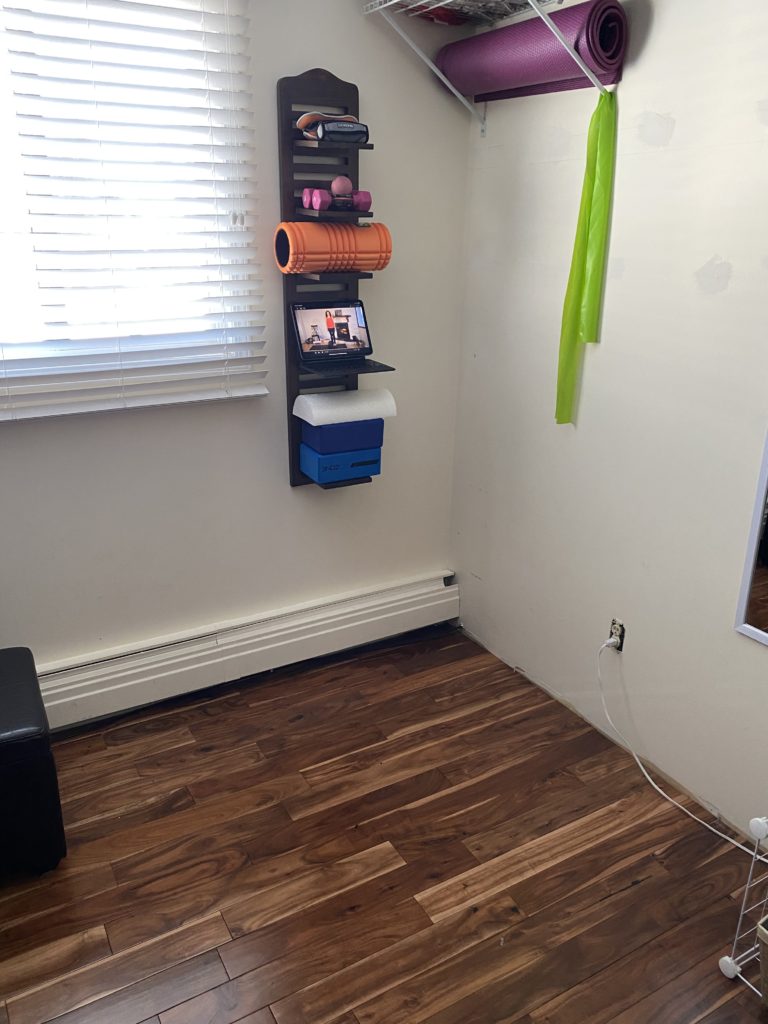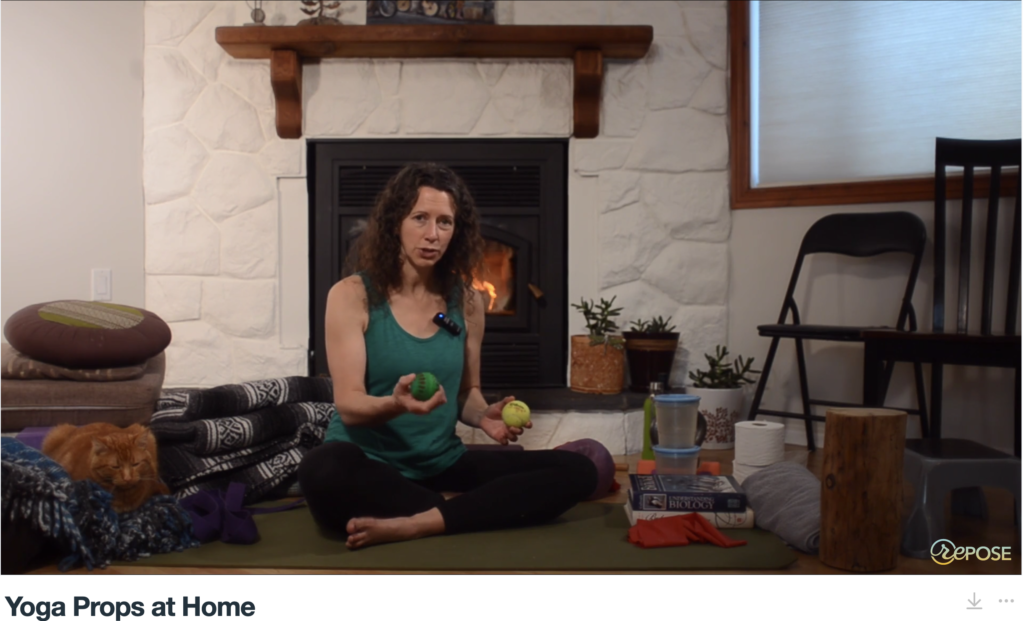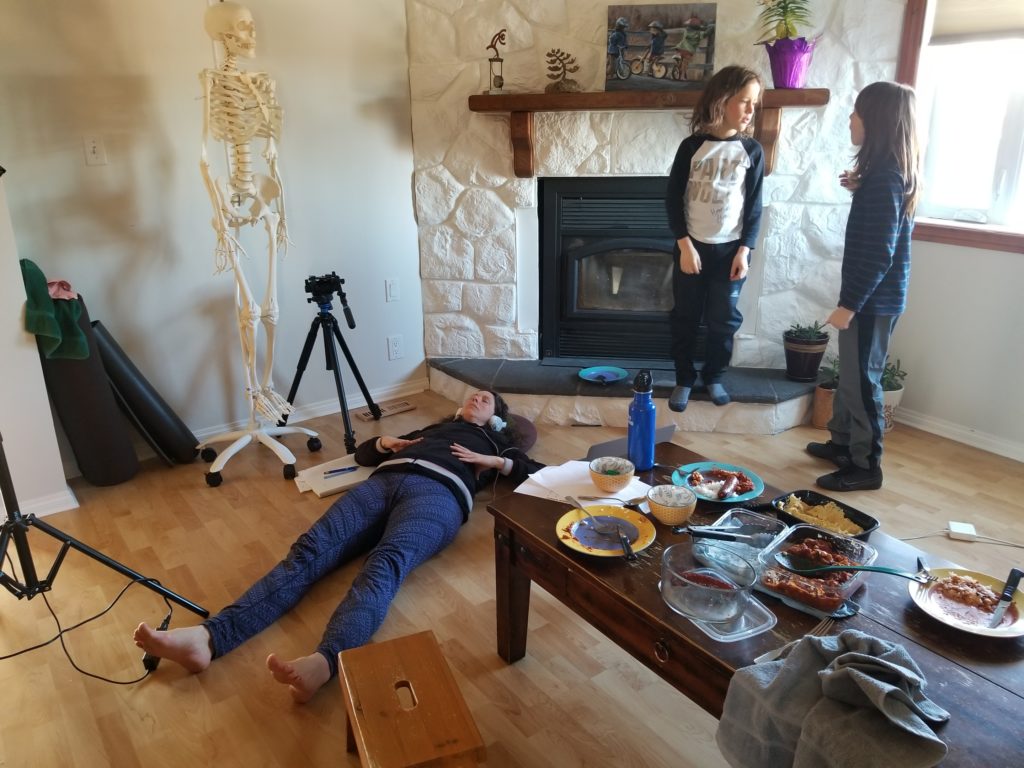So we’re a year into the pandemic and I’m finally creating a blog post to address some of the common challenges people have shared with me around practicing yoga at home. If you’re short on reading time here’s the conclusion: practicing at home is way simpler than you might think AND may even bring more stillness and calm to your life than practicing at a studio.
Here are the top reasons people have told me they have difficulty practicing at home:
- Trouble finding a distraction-free space
- Hard to commit to the time
- Not owning bolsters and yoga props
- Worried about practicing incorrectly without a teacher to observe and guide
- Lacks the community & connection of going to a group class
- Zoom fatigue
I’m going to tackle all of these challenges in this post AND add a few points about why a home practice can both be more convenient and offer more benefits than the pre-pandemic way of going to a scheduled studio class to practice.
Distraction-free Space
At home there are kids, noises, furniture and all sorts of distractions and obstacles that weren’t there when we removed ourselves to go somewhere else to practice. It was like a mini-reprieve from the chaos of life. How will we ever be able to re-create that at home?
It’s actually simpler than you may think and may involve changing ideas of how perfect and serene a practice space really needs to be. The benefits of taking even 20 minutes/day to focus and be present in an awareness or breath-centred yoga practice include reduced feelings of stress or anxiety, improved sleep and overall feelings of wellness, so it makes sense to figure out a way to make it work.
Here’s a little secret: practicing amidst chaos may actually advance your practice of yoga more than practicing in a serene environment.
Pratyahara is one of the 8 limbs of yoga, and some would say the most important. It is often translated as a withdrawal from the senses. It is a practice of learning how to take our attention inward and away from the external influence of sensory input from our environment. It is about being aware of our surroundings but not having our internal focus distracted by them. Pratyahara is a preparatory step for the deeper levels of concentration required for meditation. In a completely distraction-free environment (like a tranquil yoga studio) it is relatively easy to take our attention inward – but this may not develop the skill of pratyahara in a way relevant to life. Practicing being able to turn our attention inwards – to be aware of our breath, sensations, thoughts, feelings – while surrounded by potential distractions is advanced yoga!
To practice yoga at home you only need enough space to roll out your yoga mat (you don’t even need a yoga mat, just the space for one). You can create a yoga corner, as one of my clients did (see photo below), or find space at the foot of your bed or in your living room. If there are other people at home, invite them to practice with you or at least ask for some quiet time. If you have multiple rooms, roll your mat out in one and close the door. If you can still hear noise from others in your house remember you are practicing how to tune in to yourself amidst external distraction.

Allow your practice to be less perfect. If you have young children let them alternate between trying it out with you and climbing on you while you practice. This can provide important connection and play time with your kids and making this a habitual routine will also get them used to you taking time to practice and they will be more able to respect this as they get older. It also teaches them about the importance of self-compassion – that you recognize the importance of caring for yourself and are committed to offering yourself this self-kindness, allowing you to recharge and be more able to compassionately care for them. Demonstrating this for your kids is good role-modeling of the importance of self-compassion, something we could all benefit from.
Here are a couple of photos of me practicing recently with a live online pranayama (breath practice) workshop. It was during supper – see my headphones? It wasn’t perfect – I alternated between doing the breath practices and answering my kids’ questions – but I still felt calmer and more relaxed after.
Finding Time
It is so easy to get caught up in our chores, hobbies and to-do lists at home. When we used to plan to go to a scheduled yoga class, we made that commitment to that time. How can we make the time for a home practice?
The quick answer here is “less is more.” Traditional yoga classes are 90 minutes. Most yoga studios had cut that down to 75, 60 or even 45m to accommodate busy lifestyles. And the truth is you don’t need to schedule 90 minutes or even a full hour to practice. A consistent, daily (or almost daily), 20-minute practice may provide greater connection than a once/week longer practice. And let’s be honest, how many times in a month did something get in the way of making it to that scheduled class in the week?
Here are a few ideas to make sure you schedule the time to practice at home:
- If you normally take a moment at the start of your week to look at what’s scheduled and what your week holds, schedule in specific times for your practice and put it in your calendar. Commit to yourself to set that time aside for you and make it as important as any other commitment.
- If you have a goal of 20m/day to practice, make a daily ritual out of it. Maybe 6am is your daily time. Maybe 9pm works better for you. Find the rhythm that works.
- When you find moments in your week that you can’t seem to focus on what you had planned to do, or maybe someone canceled a meeting or plans you had together, take advantage of those moments as perfect opportunities to practice and find some much-needed grounding and calm.
And remember, you don’t have to create perfect serenity to practice. Maybe you’ve got something in the oven for supper – practice while you wait!
Yoga Props at Home
Last spring when Covid-19 shutdown yoga classes everywhere, I made this free video on Facebook to show you how to fashion yoga props from things you likely have at home.
I made another more detailed version of this tutorial for my online class membership.

You can use blankets, pillows, couch cushions, hardcover books, and all kinds of things from your home to prop up your practice. Fancy yoga props are not required. Once you’ve established your home practice, then choose whether it makes sense to invest in a few yoga props.
Practicing the Postures Correctly
Perhaps one of the biggest concerns around practicing at home is the concern around not knowing if you’re doing it right and not wanting to develop bad habits, practice with bad form, or cause harm or injury to yourself.
This is such a big and important topic that I have plans to dedicate a future blog post to cover this more fully. Essentially though, the yoga and fitness industry has mistakenly and overzealously promoted the importance of alignment and form for safety and this has caused more harm than good in terms of creating fears around movement, expectations of injury, and dependence on “knowledgeable” movement instructors at the expense of one’s own expertise of their own body. Expectation of injury for using bad form, is itself a known risk factor for persistent pain. In plain language, while poor alignment or form is not a risk factor for pain, believing that poor alignment will cause injury IS a risk factor for experiencing pain. Bonkers right?
While there are reasons for paying attention to alignment, the reasons are less about safety and more about targeting specific actions or movements and creating greater overall movement capacity and resilience.
Practicing at home, you get to be the expert on you and your body. You get to decide what alignment feels right for you on any given day, and in doing so, you are developing your skill of self-awareness, you are developing your body-mind connection, your body awareness, your interoceptive skill (awareness of what is happening inside your body), and becoming more self-reliant. When you are paying attention to your own internal signals rather than the shapes of the yoga teacher or other people in the room, you are more likely to practice in a way that specifically benefits you. While I provide some guidance on alignment in my online classes, I aim to provide options and to encourage you to find the best version for your body on any particular day. There is no right or wrong way to practice yoga postures.
Community & Connection
There is no doubt that the social connection provided by an in-person group yoga class is responsible for many benefits people reported from their pre-pandemic studio yoga practice in this increasingly lonely and disconnected world.
However, there has always been another version of the story of practicing yoga in groups. While many people feel connected, there are an equal if not greater number of people that have been uncomfortable to practice at studios that have not always done enough to welcome people that don’t fit the dominant yoga image around body size, mobility level, race, class, and gender.
Importantly, the practice of yoga is really about finding more connection to yourself. Something I am just learning about is that some research shows a greater connection to and compassion towards self, leads to greater compassion towards others and greater social connection. Wow, hasn’t our culture reversed this and made us feel selfish when we show compassion towards ourselves? The Dalai Lama has pointed out that in Tibetan, as well as in Sanskrit, the word for compassion implies feeling this for oneself as well as others – that self-compassion is part of compassion.
At home there is less distraction by comparing yourself to what other people in the room are doing and less worry about being judged by others. You’re free to be you and to practice as you are. In your pajamas even. And you can skip a pose or do something different and nobody will know. You can take a version of the pose (or an entirely different pose) that works for your body without any curious looks. By promoting a deeper level of self-connection and self-compassion, maybe a home yoga practice can actually improve social connection overall.
Zoom/Screen Fatigue
Full disclosure: I’ve been taking online yoga classes for nearly a decade and love them! And while during the pandemic I have felt the same Zoom or screen fatigue as everyone else has (with meetings, workshops, and family gatherings all moved to online), I have actually increased the number of online yoga and movement classes I take each week.
Someone recently told me that Zoom fatigue is due to both the constant eye contact necessary to make communicating over Zoom effective as well as the constant viewing of your own image on the screen during meetings. I believe it. Zoom is tiring. I recently participated in a 2-day training all on Zoom and it took me at least another 2 days to recover from it.
But taking online pre-recorded yoga and movement classes is more like Netflix than Zoom. It’s not even like Netflix in terms of screen time because you don’t need to be that close to the screen (or even looking at it all the time if the verbal instructions are clear). AND you are moving, breathing and being mindful so you are taking action in your body-mind while interacting with what is happening on the screen. In my experience, it is entirely the opposite of the environment that creates Zoom fatigue. Rather than feeling like my energy has been zapped, I feel totally restored.
And, as the weather permits, you can take your online class to your deck or yard and practice outside!
Final Words
There are so many body-mind benefits to committing to a consistent, regular, even 20m/day practice and it can be much easier to be this consistent and regular if you make it part of your routine at home.
Because pre-recorded online classes are available on demand you can fit your yoga into your schedule, whether that’s 6am, 2pm, 9pm or perhaps on nights you have trouble sleeping you can come to a 20m calming breath relaxation practice at 2am!
You don’t need to find childcare to practice at home and online classes are more affordable, especially if you make use of them several times each week.
When you find a class you enjoy, especially one that contains several practices or skills you are working on, you can repeat the same class several times.
If you were resisting practicing yoga at home, I hope this post has convinced you that it is worth a try. Once you get the hang of it, you might find you really enjoy it like I do! Online yoga is here to stay and there are infinite mental and physical benefits of slowing down, taking time to turn your attention inward, and developing an ability to stay grounded in this crazy world. Yoga is a perfect practice to start, or to continue, during these anxious pandemic times.
There are lots of options for practicing online and you can also develop your own home practice. Of course I’d love to have you join my online class membership. You can learn more about it and what’s included here. I develop new classes based on member requests and as the membership grows and supports it, I plan to bring in other teachers, live classes and more!
However you develop your at-home practice, just keep reminding yourself it doesn’t have to be perfect to be enjoyable or to develop peace of mind.




